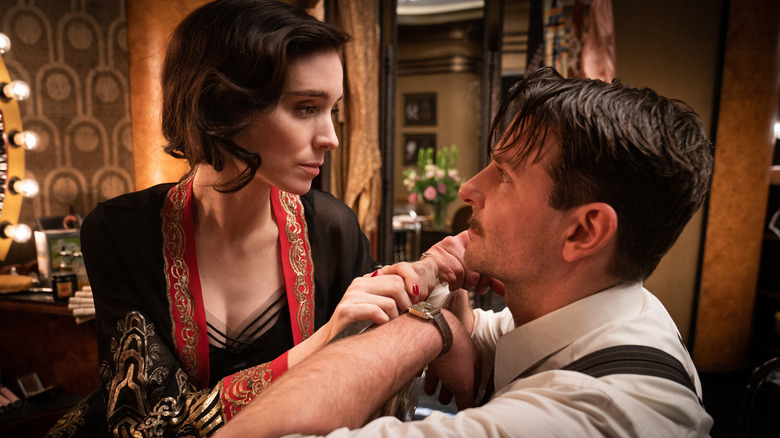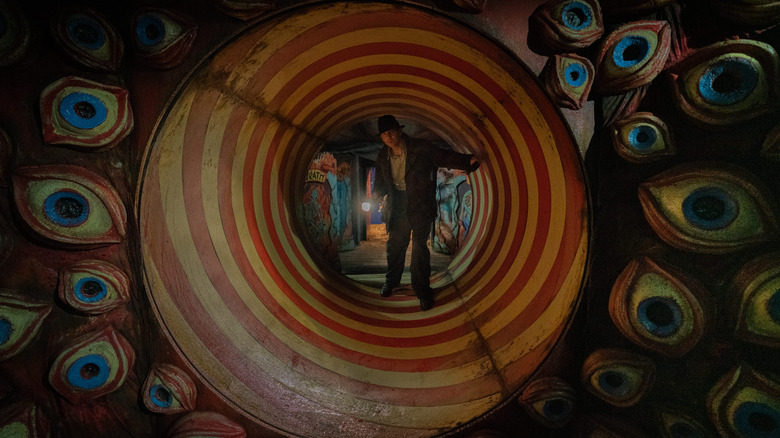
Even though Guillermo del Toro has earned a significant amount of mainstream recognition after winning Best Picture for the brilliant "The Shape of Water" -- a feat that I still consider to be something of a minor miracle given that it involved, you know, sex with a fish-man and all that -- many fans have looked forward to "Nightmare Alley" with the thrill of del Toro delivering something altogether different. The dark noir film is something of a departure for the acclaimed filmmaker, trading in literal monsters for much more human-looking ones with deep roots in the history of cinema. The film has been roundly praised for its hard-edged storytelling and gorgeous cinematography, with /Film's Chris Evangelista remarking in his review that:
"...del Toro has conjured up a hauntingly beautiful world where Ferris Wheels glow brightly against dark skies full of bolts of lightning. Where pickled specimens of dead things float in jars full of formaldehyde. Where it seems to always be cloudy. Where snow drifts down through perfectly framed windows. Where every room is choked with art deco baubles. Where a cigarette is perched in the corner of everyone's mouth. Where everyone seems slightly damned."
It might seem strange to hear that this del Toro film, of all his prior work, could very well receive a black-and-white cut of its own. But as much of a loss as it may be to be deprived of the film's sumptuous color palette, del Toro makes a pretty convincing case for why this version of "Nightmare Alley" would be worth a watch.
Black And White And Noir All Over

Guillermo del Toro has always displayed a keen eye for visuals, from his low-budget beginnings in the horror space to much larger projects such as "Crimson Peak" or "Pacific Rim." "Nightmare Alley" may very well prove to be the very height of his work in this regard. Del Toro, ever a student of his craft, ended up filming this movie as close as possible to the noir films he group up with. Black and white has always been an integral aspect of these types of movies and del Toro confirmed to IndieWire that a specific cut for "Nightmare Alley" that accommodates for this viewing experience does, in fact, exist, which he "hopes can be seen." By his own account, it wasn't as simple as merely flipping a few switches in the editing room:
"There is a version of the movie [in black and white] which I hope can be seen. It's not a movie where you turn the color off. The movie is almost like a serigraph in black and white that then has another layer of color. If you saw the movie in black and white, it's not like you just turned the color off. It looks exactly like a movie from the 1940s in a way that is astounding."
To state the obvious, we're very much inclined to take del Toro at his word on this. His exact wording doesn't seem to indicate any solid plans to actually make this version available to the public at the moment, but hopefully a future home release on Blu-ray would include this feature in the same way that George Miller's "Black and Chrome" cut of "Mad Max: Fury Road" did. For his part, del Toro goes on to explain a little of his technical approach in terms of the color of "Nightmare Alley," saying, "I was production assistant in a movie with Gabriel Figueroa, who was the greatest Mexican cinematographer. He had a great kinship with Gregg Toland, they were good friends. He said to me when you art direct for black and white, you use the greens and the reds and the golds to give the mid-tones to do all the grey color. We decided to take that palette [on 'Nightmare Alley']."
"Nightmare Alley" comes to theaters on December 17, 2021.
Read this next: The 12 Best Neo-Noir Films Ranked
The post Guillermo del Toro Confirms There's a Black and White Cut of Nightmare Alley appeared first on /Film.
0 Commentaires